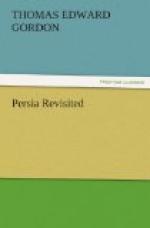There is much pleasing romance and sentiment in the popular idea regarding the origin of the national emblem, Sher o Khurshed (the Lion and the Sun). The following legend concerning it was told to me by the Malik-ut-Tujjar, or Master of the Merchants of Tehran, a gentleman well versed in Persian history, literature, and lore, and who spoke with all the enthusiasm of national pride. When the first monarchy of Ajam (Persia) was founded by Kai Uramas, some five thousand years ago, the sun was in the sign of Asad (Leo), the highest tower in the heavens, and the lion was therefore taken as the Persian emblem, and it so remained without the sun over it, as now shown, till about six hundred years ago. Ghazan Khan, who then reigned as King, was so attached to his wife, the Queen Khurshed (the Sun), that he desired to perpetuate her name by putting it on the coins he struck; but the Ulema objected to a woman’s name on the King’s coin, whereupon he decided to put her face on a rising sun above the national emblem of the lion, as now seen in the well-known royal arms of Persia. The story is that King Ghazan’s affection for his Queen, Khurshed, was such that he styled her Sham’bu Ghazan (the Light of Ghazan).
This may have been the origin of the expression Khurshed Kullah, or Sun-crowned, which I have seen stated is a term that was used to denote the Sovereign of an empire, but from the fact of the features and style of dressing the hair shown in the sun-picture being those of a woman, I think the title may be regarded as applied only to queens. Catherine II. of Russia, from the magnificence of her Court, her beauty and ambition, and her fame in love and war, was known in Persia during her lifetime as Khurshed Kullah, and she is still designated by that title.
I would here mention another instance of a Mohammedan monarch desiring to publish to his people in the most sovereign manner his high regard for a wife by putting her name on the current coin. The reign of the Emperor Jehangir, son of Akbar the Great, the founder of the Moghul Empire in India and the builder of Agra, was chiefly remarkable for the influence exercised over him by his favourite wife, Nur Mahal, the Light of the Harem, immortalized by Moore in ‘Lalla Rookh.’ The currency was struck in her name, and we are also told that in her hands centred all the intrigues that make up the work of Oriental administration. She lies buried by the side of her husband at Lahore, the capital of the Punjab.




